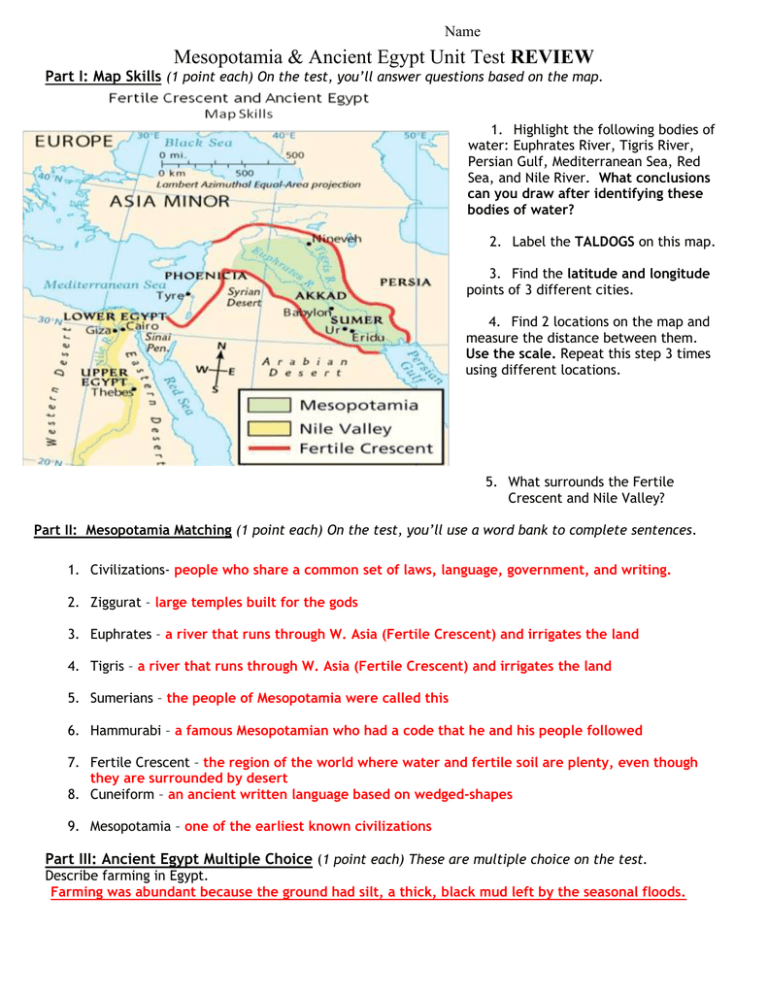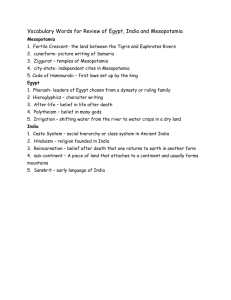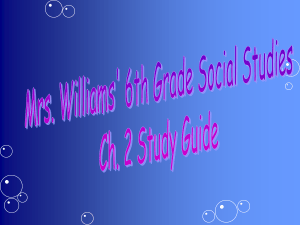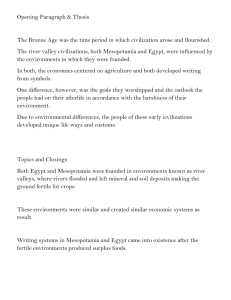Part V - The Fightin' Gnomes
advertisement

Name ________________________________ Mesopotamia & Ancient Egypt Unit Test REVIEW Part I: Map Skills (1 point each) On the test, you’ll answer questions based on the map. 1. Highlight the following bodies of water: Euphrates River, Tigris River, Persian Gulf, Mediterranean Sea, Red Sea, and Nile River. What conclusions can you draw after identifying these bodies of water? 2. Label the TALDOGS on this map. 3. Find the latitude and longitude points of 3 different cities. 4. Find 2 locations on the map and measure the distance between them. Use the scale. Repeat this step 3 times using different locations. 5. What surrounds the Fertile Crescent and Nile Valley? Part II: Mesopotamia Matching (1 point each) On the test, you’ll use a word bank to complete sentences. 1. Civilizations- people who share a common set of laws, language, government, and writing. 2. Ziggurat – large temples built for the gods 3. Euphrates – a river that runs through W. Asia (Fertile Crescent) and irrigates the land 4. Tigris – a river that runs through W. Asia (Fertile Crescent) and irrigates the land 5. Sumerians – the people of Mesopotamia were called this 6. Hammurabi – a famous Mesopotamian who had a code that he and his people followed 7. Fertile Crescent – the region of the world where water and fertile soil are plenty, even though they are surrounded by desert 8. Cuneiform – an ancient written language based on wedged-shapes 9. Mesopotamia – one of the earliest known civilizations Part III: Ancient Egypt Multiple Choice (1 point each) These are multiple choice on the test. Describe farming in Egypt. Farming was abundant because the ground had silt, a thick, black mud left by the seasonal floods. Mesopotamia & Ancient Egypt Unit Test REVIEW Explain the following contributions of Ancient Egypt: Language – They had a written language of hieroglyphics used to communicate. Water System – The seasonal floods were used to irrigate, build, and to help farm. Pyramids – These were built to honor the pharaohs, along with tombs and temples. Mummification – This process preserved the bodies of pharaohs for the afterlife. List three reasons why the Nile River is considered a “gift to the people of Egypt.” 1. Provides water for irrigation, used by Egyptian farmers. 2. Seasonal floods brought in silt, fertilizing the soil. 3. It served as a transportation route. Part IV: Mesopotamia and Egypt True/False (1 point each) On the test, there will be statements that you will have to identify as True or False. Seasonal floods - Meso and Egypt had fertile soil because of these. Water and soil – Civilizations set up in Meso/Egypt because of these two things. Trade – All of the bodies of water allowed for lots of trade in Egypt and Meso. Identify (1 point each) On the test, you’ll have a list of inventions. You’ll need to label them “M” if they were developed in Mesopotamia or “E” for Egypt. Mesopotamia Cuneiform Ziggurat Plow Wheel Egypt Pyramids Mummification Hieroglyphics Part V: Apply (5 points) “Mesopotamia is considered the Cradle of Civilization, since so many of the earliest advanced civilizations materialized in this region. Agriculture, urbanization and writing are the primary prerequisites, all of which took root in ancient Mesopotamia.” Directions: Read the text below and highlight two examples that show Mesopotamia is a civilization. Then write why it shows it in the box in the margin. Mesopotamia & Ancient Egypt Unit Test REVIEW ~You will be given a text to read through on test day.~ As preparation, list three or four characteristics of a civilization. 1. Language 2. Laws 3. Government 4. Writing


